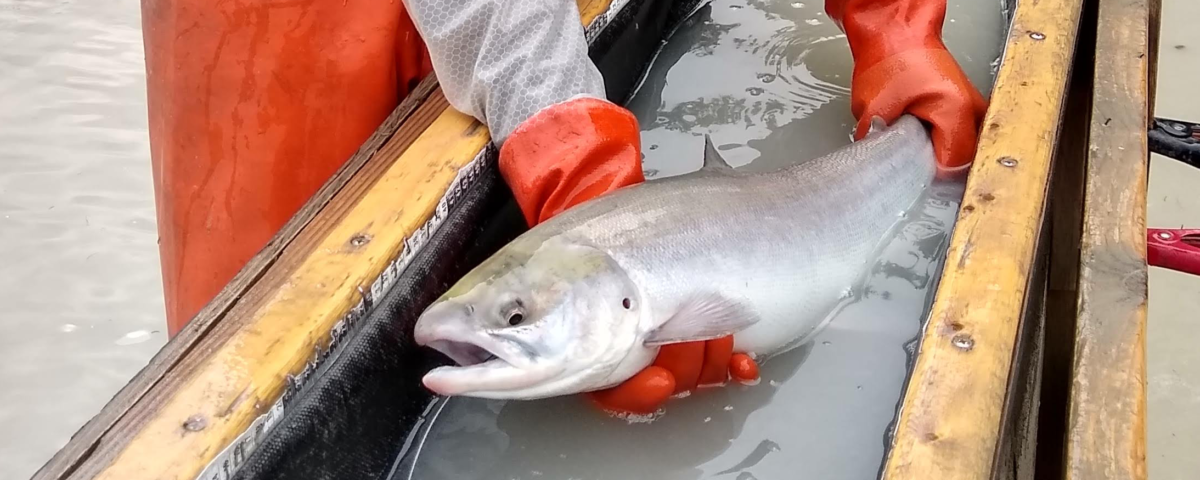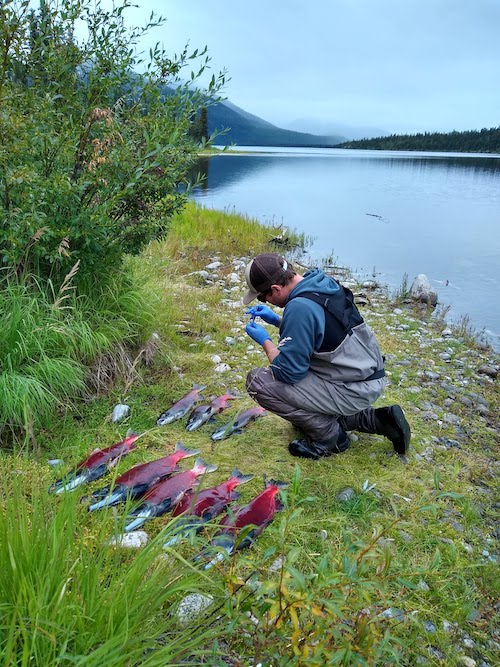Copper River Sockeye Salmon Size Predicts Migratory Success

2019 data analyzed for preliminary results of migration study
By Teal Barmore, May 11, 2020
During the summer of 2015, the commercial fishing community in Cordova, Alaska was abuzz with rumors about why the fisherman were not catching fish, even though the escapement monitored by the Alaska Department of Fish and Game (ADF&G) was showing plenty of sockeye returning to the river system. Because of unusually warm waters, some people suspected that fish were moving deeper to colder water and going under their nets. Ecological researcher Dr. Kristen Gorman discussed this with one fisherman, but he disagreed. According to him, the fish weren’t going under the nets, they were going through them. The fish were coming back at smaller body sizes, which required smaller fishing gear than usual for Copper River reds to be effective. Kristen was intrigued by this new idea and discussed the issues with Dr. Pete Rand who contacted ADF&G fisheries biologists to examine their body size and condition data that ADF&G collects for this fishery. The data confirmed that fish were coming back at smaller body sizes in 2015 and that the fish also had a reduced body condition (i.e., low weight for a given length). “This got us thinking that there may be a problem with these fish having enough energy to get to the spawning grounds,” said Pete. Some of the spawning populations of the Copper River travel over 300 kilometers in glacial waters – an energy intensive journey. Were these smaller, skinnier fish that seemed to be associated with a warming ocean equipped for these long-distance migrations? What factors were influencing their successful migration to the upper river?

Researchers are using locator radio tags to track Sockeye in the Copper River. Tags are inserted down the throat of the fish into their stomach, and the antenna extends out of their mouth. These fish do not eat during their migration, so it does not affect feeding. Fishermen that catch tagged fish are encouraged to return tags to drop boxes or by mail to Pete Rand.
The project that resulted from these questions was funded by the North Pacific Research Board (NPRB) and the Alaska IDeA Network for Biomedical Research Excellence (INBRE); data collection began over the summer of 2019. Kristen and Pete combined traditional research standards with some new technologies for a broad look at the overall condition of the fish to compare with their migratory success, which they tracked with radio tags.
Over the course of a full field season in the lower river, Kristen and Pete plan to sacrifice 60 sockeye salmon for body composition analysis and take basic measurements on 300 live fish that they radio tag and release. The samples are collected from the early, middle, and late Copper River sockeye runs at the Native Village of Eyak’s lower Copper River fish wheel site. Later in the season the research team will search the spawning grounds in the upper watershed for tagged fish and sacrifice additional sockeye to study body composition of the successful migrants.
Of the fish that are sacrificed (50% female, 50% male), researchers measure their physical dimensions and weight, take tissue samples from their gills and fins for genetic, pathogen, and gene expression work, weigh gonads, and run a microwave sensor that measures fat content across the bodies of fish before processing the fish to determine energy density of their body tissue in a bomb calorimeter.
This in-depth body condition data from the sacrificed fish will be used as a baseline estimate for the body condition of tagged fish that undergo a less rigorous sampling protocol. “We strive to minimize handling and stress on our tagged fish, so we quickly measure size of fish, take a gill and fin clip, and a few microwave measurements before releasing them back to the river, an operation that takes less than 3 minutes”, Pete describes.
Upriver, an additional fish are sacrificed from 7 different spawning locations to compare body condition and health measures. These comprehensive data sets from different populations will give Kristen and Pete a way to look at how each of the populations are locally adapted and how they are coping with changing river conditions.
While traveling around the upper watershed to collect samples the researchers track the tagged fish on their journey to the spawning grounds. Between the tagging site and their destination, a successful spawner must navigate the turbulent waters of Wood Canyon, one of the most challenging parts of their spawning migration. Pete describes his first experience while traversing it on a skiff over the past summer: “The canyon reaches are full of muddy, silty water, with huge back eddies and whirlpools, sometimes filled with logs and other debris from upriver. It has to be daunting for a salmon to navigate and swim through”.

Research Assistant Sean Den Adel preserves gill tissue from sockeye sacrificed at one of the spawning ground study sites. Photo: Pete Rand
As preliminary results from the 2019 field season show, this is no easy feat! Of the 198 fish that were equipped with radio tags only a quarter of them made it through Wood Canyon to Chitina. Kristen and Pete point to unusual conditions as a possible reason for this unexpected result. Record high air temperatures led to record high flood conditions in the Copper River as a result of rapid snow and glacial melt. Their funding became available just in time to catch the mid-season salmon run, which bore the brunt of the flooding. Upstream of Wood Canyon twelve tags were returned by harvesters that caught these fish. Only five of the original 198 fish made it to spawning grounds based on detections during aerial surveys through the season. Over the winter Pete and Kristen analyzed data for insight into what made a successful migrant in 2019. In the preliminary results one factor clearly stood out – size. The fish that successfully migrated to the spawning grounds were 2 cm longer than their failed counterparts. This trend held true for the fish that made it as far as Chitina as well. The superior swimming ability associated with larger fish may have helped them beat the odds in the flooding, turbulent river.
Other factors could, of course, be at play, including energy reserves (fat), pathogens and other physiological stress factors. The data looking into these other factors that could be predicting migratory success are yet to be analyzed.
For both Kristen and Pete, the really exciting part about this project is in its potential for the results to inform the management of an incredibly important resource in this region. This new study focuses on the quality of the fish returning. As Kristen points out, not all fish returning are created equal, and some will surely be unsuccessful in their journey to the spawning grounds. Understanding what might be causing mortality of fish while enroute to the spawning grounds is one of the key issues their study is addressing. Conditions in the ocean are clearly changing, and there are consequences that can extend all the way to the headwaters of the Copper River. Results from this project have the potential to start an important conversation on how the ocean and river is changing and how salmon management might need to adapt to a changing climate.




